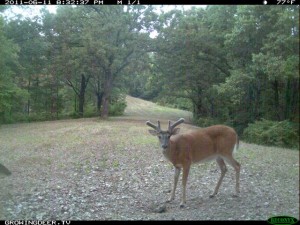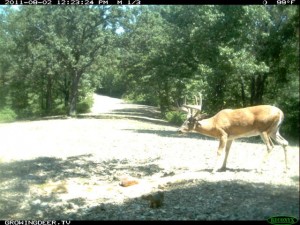Antler Growth
Filed under: Deer Hunting, Hunting Blog, Trail Cameras
There can be no argument that man has been intrigued by antlers and antler growth since the beginning of time. Antlers were the frequent subject of paintings, carvings, etc., by prehistoric man. I’ve yet to meet the child that didn’t accept an antler from my hand when offered. They tend to study the antler, count the points, rapidly notice the unique characteristics, etc. Almost everyone that visits my home comments on the light fixtures made from antlers or the sheds that Tracy uses to decorate our house. Antlers captivate humans from all cultures.
As a scientist and hunter, antlers captivate me. I understand the basics of how antlers are formed – the annual cycle of storing and mobilizing minerals. However, for a critter to grow something the size of a man’s arm and replace it annually is truly a miracle that even science struggles to understand fully.
As a hunter that appreciates creation, the fact that every antler is unique (like a human finger print) is astounding! I just finished the trail camera survey at my property. The unique shape of each buck’s antlers allowed me to identify dozens of unique bucks (from young to old). I wait until mid August to implement trail camera surveys each year so the antlers are developed enough to allow each buck to be specifically identified.
 The image on the left taken during June is of a buck I call Clover Mountain Crab Claw. This buck has been present on my property for years. He is at least six years old. His rack has changed from having 8 points to 9 points and back to 8 typical points this year. I can usually accurately identify Clover Mountain Crab Claw by his body – he’s a tank! However, I wait until August to definitively confirm his identify and know that he has survived and avoided me for another year.
The image on the left taken during June is of a buck I call Clover Mountain Crab Claw. This buck has been present on my property for years. He is at least six years old. His rack has changed from having 8 points to 9 points and back to 8 typical points this year. I can usually accurately identify Clover Mountain Crab Claw by his body – he’s a tank! However, I wait until August to definitively confirm his identify and know that he has survived and avoided me for another year.
 Hunting on the same property year after year allows sportsmen to learn much from the bucks whose range overlaps at least a portion of that property. It allows hunters to learn the general habits of bucks, and if they are good students, the individual movement patterns of each buck. Some bucks have a very large home range. Clover Mountain Crab Claw has a very small home range – as his picture is rarely captured at more than one camera station on my property.
Hunting on the same property year after year allows sportsmen to learn much from the bucks whose range overlaps at least a portion of that property. It allows hunters to learn the general habits of bucks, and if they are good students, the individual movement patterns of each buck. Some bucks have a very large home range. Clover Mountain Crab Claw has a very small home range – as his picture is rarely captured at more than one camera station on my property.
Watching the progress of antlers growing during the summer fascinates me. In addition, it allows me to learn the vast majority of bucks using my property. This is a huge benefit when hunting during the fall and trying to play by my own harvest guidelines. By being very familiar with the antler configuration of most of the 4+ year old bucks I can make rapid decisions of whether to shoot or not when a buck that appears mature comes in range. The thrill of being able to recognize the individual buck and know his estimated age is as fun to me as any other portion of the hunt.
Antlers are mysterious from a science and deer hunter’s point of view. They motivate us to spend gads of hours and resources attempting to learn more and obtain them. There is great value in antlers – and I believe the bulk of this value occurs before the buck is harvested. Those cave paintings have lasted and intrigued man for at least a few thousand years. So this fall when I’m spending many hours attempting to get my hands on a set of mature antlers, feel free to remind me of the joy I’ve already experienced watching one of the great mysteries of creation – watching antlers grow. If Clover Mountain Crab Claw avoids me again this year, I’ll still enjoy searching for his sheds and maintaining good quality habitat so I can see how his antlers develop next summer.
Growing (and chasing) Deer together,
Grant



